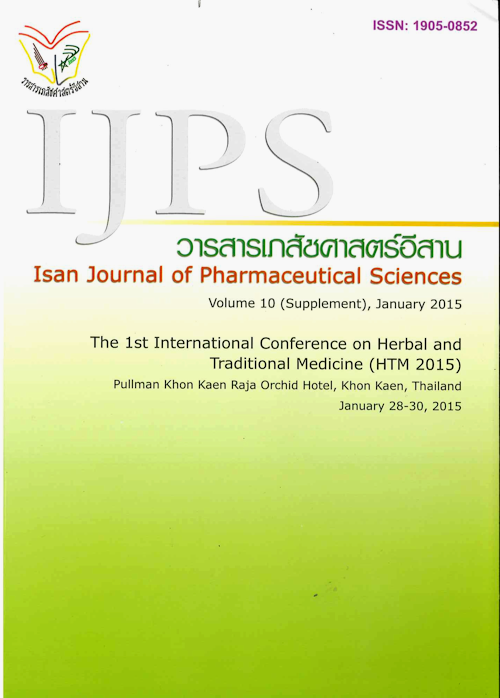Screening of Medical Plants Extracts for Larvicidal Activity against Culex quinquefasciatus (Diptera: Culicidae)
Main Article Content
Abstract
nematode, Wuchereria bancrofti, which is a seriously problem in several tropical and subtropical
countries. Plant extracts, especially essential oils have been used as minor natural resource of insec
ticides. They constitute a goodsource of bioactive compounds that are biodegradable into nontoxic
products. To evaluate the larvicidal effects of the different plant extracts, Cx. quinquefasciatus larval
stage were tested in this study. Methods: Effi cacy of 21 essential oils extracted from steam distillation
was screened against fi larial vector, Cx. quinquefasciatus, for their larvicidal activity at the concentration
of 1,000 ppm in a preliminary study. The 3rd-4th instar larvae of Culex mosquito were exposed to
extracted oils at different concentrations (25, 50, 75 and 100 ppm). Results: Of these, nine oils viz.
kaempfer oil, holy basil oil, chinese chives oil, galanga oil, turmeric oil, dark blue temu oil, citronella
grass oil, kaffi r lime oil and sweet basil oil exhibited 100%larvicidal activity at 1,000 ppm. These nine
oils were screened further against Cx. quinquefasciatus, for their larvicial effect at different concentra
tions (25, 50, 75 and 100 ppm). Percentage mortality was determined after 24 hours exposure. The
highest potential was established from kaempfer, followed by turmeric, holy basil, chinese chives,
galanga, dark blue temul, kaffi r lime, citronella grass and sweet basil, with LC50 values of 13.29, 17.54,
18.74, 20.59, 25.18, 25.93, 63.22, 68.34 and 71.38 ppm, respectively. Conclusion: Regarding these
results, these oils could be used to develop a new formulation to control mosquito-borne disease
vectors.
Article Details
In the case that some parts are used by others The author must Confirm that obtaining permission to use some of the original authors. And must attach evidence That the permission has been included
References
Abbott WS. A method of computing the effectiveness of an insecticides. J Eco Entomol1925; 18: 265-267.
Batallán G, Douthat B, Flores S, et al. Larvicide activity of Larreacuneifolia (Zygophyllaceae) on Aedesaegypti (Diptera: Culicidae). Argentine Society of Biology, Eleventh Multidisciplinary Workshop. BIOCELL 2010; 34: A79-A108.
Batallán G, Torre R, Flores F, et al. Larvicidal activity of crude extracts from Larreacuneifolia (Zygophyllaceae) and of its
metabolite nordihydroguaiaretic acid against the vector Culexquinquefasciatus (Diptera: Culicidae) Rev Soc Bras MedTrop 2013; 46(1): 84-87.
Finney DF, Probit Analysis (3rded.). Cambridge University Press, London 1971; 333 pp.
Foster WA, Walker ED. 2002. Mosquitoes (Culicidae). In Mullen, G., Durden, L. (Eds.) Medical and Veterinary Entomology (p 203-262). Academic press, San Diego, CA. 597 pp.
Forattini OP, Kakitani I, Massad E, et al. Studies on mosquitoes (Diptera: Culicidae) and anthropic environment. 1 - Parity of blood seeking Anopheles (Kerteszia) in South-Eastern Brazil. Rev SaúdePública 1993; 27:1-8.
Kaushi R, Saini P. Screening of some semi-arid region plants for larvicidal activity Against Aedesaegypti mosquitoes. J Vector Borne Dis 2009; 46: 244-246.
Llinas GA, Eccacini ES, Ardenal CNG, et al. Current resistance status to temephos in Aedesaegypti fromdifferent regions of Argentina. MemInst Oswaldo Cruz 2010; 105 (1): 113-116.
Mathew N, AnithaMG, BalaTSL, et al. Larvicidal activity of Saracaindica, Nyctanthes arbor-tristis, and Clitoriaternatea extracts against three mosquito vector species.Parasitol Res 2009; 104: 1017–1025.
Prakash A, Rao J. Botanical pesticides in agricul-ture. CRC Lewis Publs. Boca Raton, USA. 1997; 481
PPPumidonming W, Polseela P, Maleewong W, et al. Culexquinquefasciatus in Phitsanulok as a possible vector of nocturnally periodic Wuchereriabancrofti transmission in Myanmar immigrants Southeast Asian J Trop Med Public Health 2005; 36(4): 176.
Rattanarithikul R, Harbach RE, Harrison BA, et al. Illustrated keys to the mosquitoes of Thailand. II. Genera Culexand Lutzia. Southeast Asian J Trop Med Public Health 2005; 36(2): 1–97.
Service MW. Biological control of mosquitos – has it a future? Mosquito News 1983; 43: 113–120.
Statistical Package for Social Sciences, SPSS for Windows. User’s guide: Statistics version 16. SPSS Inc. Cary, NC, USA, 2007.
Suman DS, Parashar BD, Prakash. S. Effect of sublethal dose of diflubenzuron and azadirachtin on various life table attributes of Culexquinquefasciatus(Dipter: Culicidae). J Med Entomol2008; 47: 996-1002.
Tikar SN, Mendki MJ, Chandel K, et al. Susceptibility of immature stages of Aedes (Stegomyia) aegypti, vector of dengue and chikungunya to insecticides from India. Parasitol Res 2008; 102(5): 907-913.
World Health Organization. Instructions for determiningsusceptibility or resistance of mosquito larvae to insecticides. Geneva: WHO 1981: 807.


